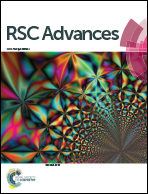A comprehensive study on the dominant formation of the dissolved Ca(OH)2(aq) in strongly alkaline solutions saturated by Ca(ii)
Abstract
The solubility of calcium hydroxide and the aqueous speciation of Ca(II) in alkaline medium at various temperatures and background electrolyte concentrations were characterized by solubility measurements applying ICP-OES and potentiometric detection methods. Contrary to suggestions from previous literature, the (dissolved) Ca(OH)2(aq) was found to be the dominant solution species above pH ∼ 13, although the well-known CaOH+(aq) is also formed to a much smaller extent. The solubility product, as well as the formation constants for the species CaOH+ and Ca(OH)2 were found to be (8.8 ± 0.2) × 10−5 M3, (1.5 ± 0.1) M−1 and (4.7 ± 0.1) M−2, respectively, at 25 °C, at 1 M ionic strength and expressed in terms of concentrations. The most important implication of this model is that the total concentration of the dissolved calcium(II) cannot be decreased below ca. 2 × 10−4 M at any base concentration, even if this is increased to the solubility limit of the caustic. This statement was further validated via precipitation titrations. The standard enthalpies and entropies of the reactions were also calculated from temperature-dependent solubility measurements.


 Please wait while we load your content...
Please wait while we load your content...